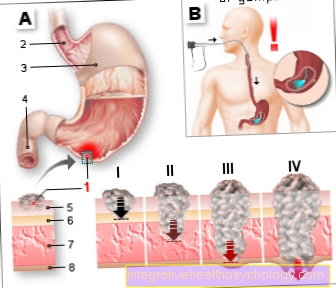Paracetamol in pregnancy
introduction
Paracetamol is a pain reliever and one of the non-opioid analgesics. It has an analgesic and antipyretic effect.
The name Paracetamol comes from Paraacetylaminophenol. This is the chemical substance that makes up the drug. Paracetamol is usually very well tolerated and is therefore used relatively frequently. In Germany it is available in pharmacies without a prescription.
Paracetamol can be used at any age if the dosage is adjusted. The pain reliever is only taken long-term in exceptional cases.
It is the pain reliever of first choice during pregnancy, as other drugs such as aspirin are contraindicated due to possible consequential harm to the baby.

How paracetamol works
How paracetamol works is not yet fully understood. It is a non-acidic non-opioid analgesic, unlike the acidic non-opioid analgesics (ASA, ibuprofen).
After ingestion, the paracetamol accumulates in the central nervous system (made up of the brain and spinal cord). It inhibits the subform of the enzyme COX-3. The COX-3 (=Cyclo-oxygenase 3) produces prostaglandins in an uninhibited state. These are messenger substances that play an important role in the development of inflammation and fever. They also influence the pain transmission process.
Paracetamol mainly has a fever-lowering (antipyretic) effect, the anti-inflammatory (anti-inflammatory) effect is rather weak. Other effects of paracetamol are also discussed.
Use of paracetamol during pregnancy
Paracetamol can generally be used during pregnancy. However, since pregnancy is a special situation, strict indications should be given, i.e. the intake should be carefully considered. You should also consult your doctor before taking paracetamol during pregnancy.
However, studies on the use of paracetamol during pregnancy show that there is no increased risk. Studies have shown that there have been no undesirable side effects with regard to the course of pregnancy or the health of the unborn child. Furthermore, there is no evidence of an increased occurrence of malformations, for example. In addition, prospective studies have shown that the number of malformations did not increase even in the event of an accidental overdose.
However, new studies suggest a connection between the use of paracetamol during pregnancy and the increased incidence of asthma in children. There is also a study that shows that taking it could lead to a later developmental delay in the child.
Paracetamol should under no circumstances be taken as a long-term medication during pregnancy, as no data exist for this case and therefore safety for the mother and the unborn child cannot be guaranteed.
Taking paracetamol in a higher dose is also strongly advised against during pregnancy, since here, too, the harmlessness has not been proven. Furthermore, paracetamol must not be combined with other medications during pregnancy, as the data are not sufficient here either and there are therefore potential risks.
In addition to pregnancy, the use of paracetamol should also be carefully considered while breastfeeding and clarified with the attending physician. Studies have shown that paracetamol passes into breast milk in small doses and is therefore absorbed by the infant. Nevertheless, no undesirable effects are known to date. For this reason, paracetamol can be taken in normal dosage during breastfeeding.
You might also be interested in the topic:
- Paracetamol while breastfeeding
- Respiratory infection in pregnancy
Dosage and frequency of intake
During pregnancy, paracetamol can be taken in a dose of 500 to 1000 mg (usually one or two tablets) up to three times a day for pain or fever.
However, the drug should only be taken for a maximum of ten days per month.If the symptoms cannot be alleviated by the dosage mentioned, you should consult your gynecologist (gynecologist) or your family doctor.
Are there differences in the intake within each trimester?
Unlike most other pain relievers, paracetamol can be taken during all three phases of pregnancy (trimesters) to relieve pain or fever.
This is also one of the reasons why paracetamol is generally recommended as the pain reliever of choice during pregnancy. Alternatively, certain other pain relievers can be taken during the first two trimesters. In the last trimester (seventh to ninth month of pregnancy), however, only paracetamol may be used, as all other pain medication can lead to developmental disorders in the future child or even to miscarriage.
What is the dosage for a headache?
In the case of mild to moderate headaches, taking 500mg paracetamol (usually equivalent to one tablet) often leads to relief.
In the case of very severe headaches, 1000mg can also be taken at once. The pain reliever can be taken a maximum of three times a day. If the headache does not stop or recurs, it is recommended to see your doctor or gynecologist. Paracetamol may not be taken more than ten days a month, as otherwise the medication itself can lead to headaches.
Also read:
- Headache in pregnancy
What dosage can you take for toothache?
Either 500 mg or 1000 mg paracetamol can be taken for toothache relief. The drug can be taken up to three times a day. In the event of toothache, however, a dentist should be consulted promptly during pregnancy so that the cause of the pain can be treated in a targeted manner.
- Toothache During Pregnancy
What dosage do you take for back pain?
Back pain can occur more frequently during pregnancy and can be treated with paracetamol. A dosage between 500 and 1000mg should be chosen, which is taken up to three times a day.
If necessary, changing the pillow or doing back exercises can also help to get rid of the pain. However, if the pain persists or persists for several days, a doctor should be consulted.
More information on this topic:
- Back pain in pregnancy
Side effects of paracetamol
In general, it can be said that when paracetamol is taken in the appropriate dose, side effects occur only rarely (? 0.01% to <0.1) or very rarely (? 0.01% in individual cases).
Possible side effects are:
- Increase in certain liver enzymes (e.g. transaminases)
- Bronchospasm (very rare, mostly in known asthmatics (analgesic asthma))
- serious changes in the composition of the blood, thrombocytopenia (too few platelets), agranulocytosis
- Hypersensitivity reactions (very rarely), as simple reddening of the skin or more severe symptoms (e.g. urticaria or anaphylactic shock) are also possible.
In this case the immediate discontinuation of therapy is mandatory. The occurrence of the side effects mentioned is in principle also possible during pregnancy.
Consequences of paracetamol on the baby
Paracetamol intake has no known direct effects on the health, physical and mental development of the baby. As long as the drug is taken in the specified dosage and there are no restrictions on the part of the mother, such as liver disease, paracetamol can be safely taken in any phase of pregnancy.
Too frequent or overdosed ingestion can lead to damage to both maternal and child organs. In the worst case, this can have life-threatening consequences for the expectant child and for the pregnant woman. If you have accidentally ingested too high a dosage, you must consult a doctor as soon as possible.
Can paracetamol lead to ADHD later in pregnancy?
According to the current state of science, there is no evidence that the use of paracetamol during pregnancy later increases the risk of developing ADHD in the child.
The disease is generally not infrequently diagnosed and can have many different causes. However, taking paracetamol is not one of them. This misconception is quite common, however, as recently published studies from Scandinavia and Great Britain suggest a connection between the use of paracetamol and the occurrence of behavioral problems in children. On closer inspection and evaluation of the study results, however, no cause-effect relationship can be identified between paracetamol intake and the abnormalities in the children. According to experts, the drug therefore continues to be the pain medication of choice in pregnancy.
You might also be interested in this topic:
- Causes of ADHD
Alternatives to paracetamol in pregnancy
In general, paracetamol is the pain medication of choice in every phase of pregnancy.
Often, however, pain can also be relieved by non-drug measures, so that pain killers should only be taken if these measures do not lead to relief. If paracetamol is not tolerated or not available, a drug with the active ingredient ibuprofen can be taken as an alternative in the first and second trimesters (i.e. up to and including the sixth month of pregnancy).
Under no circumstances should ibuprofen or other drugs from the group of so-called NSAIDs (non-streoidal anti-inflammatory drugs) be taken in the last three months! Otherwise, serious consequential damage or even death of the unborn child can occur. If there is any pain during pregnancy that requires treatment, a doctor should be consulted at an early stage.
- Ibuprofen in pregnancy





























